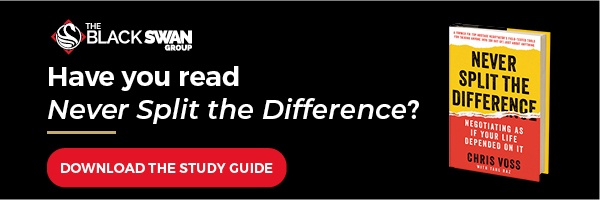First things first: Watch this absolutely hilarious Chris Voss TEDx talk on tactical empathy.
At the Black Swan Group, we use tactical empathy to deal with the Bad, the Mad, and the Sad (and sometimes even the Glad!) that we encounter every day at our jobs, in our social interactions, and even in our family gatherings.
How? With a simple three-step process:
- Tone of voice
- No denials or disagreements
- Make them feel heard
I borrowed the phrase “the Bad, the Mad, and the Sad” from Tom Strentz (with his permission) for my TEDx talk. Tom is the godfather of the FBI’s hostage negotiation program, and he’s still very active in the profession as a mentor.
Tom is truly one of the good guys. The title of one of his great books is Hostage/Crisis Negotiations: Lessons Learned from the Bad, the Mad, and the Sad. You should check it out.
Now, here’s more on the three-step process to get you started if you are tactical-empathy curious.
How to Get Started with Tactical-Empathy
1. Tone of voice
In all cases, the late-night FM DJ voice (soothing), combined with upward (inquiring) or downward (understanding) inflections, is the critical touch.
In this video, Derek Gaunt not only discusses this, but he also embodies it with his own tonality. Derek is a complete natural at the late-night FM DJ voice, which is why he was such a great hostage negotiator and is currently one of our best negotiation coaches.
2. No denials or disagreements
The key to any sort of empathy, no matter who is defining it, is no denials or disagreements. This doesn’t mean ignoring the stuff you don’t like, either. You need to make them feel heard.
3. Make them feel heard
There’s a fine line here, and it’s where the real power of tactical empathy comes from (and empathy, more broadly, for that matter). You don’t agree, but you don’t disagree, either.
Here’s an example: If you know they feel like you’re ignoring what they want, instead of denying it, call it out with a label. Don’t say, I don’t want you to think we’re ignoring what you want. Say, I’m sure it seems like we’re ignoring what you want.
That’s just an observation. You’re not agreeing, and you’re not disagreeing. And that’s tactical empathy, You’re making the tactical choice to defuse a negative by labeling it.
No one feels heard when you ignore what you’re inclined to disagree with, but these topics are precisely what you need to make them feel heard on. Anyone can make someone feel heard on the stuff you mutually agree on. That approach takes no talent or courage.
The talent and courage come into play when you make someone feel heard on the issues that are exactly where the disagreement or the anger might be.
Remember, tactical empathy isn’t an agreement. You aren’t putting your integrity on the line by calling things as they are. This frees you to use tactical empathy as a way to influence anyone in the world!
What We’re Avoiding
With this approach, we’re also avoiding the two worst practices.
1. “I understand”
Don’t say this. Ever.
Instead, take the time to articulate all that you understand. Don’t take a shortcut here.
2. “Yes, but ...” or “I understand, but ...”
No one wants you to put your “but” in their face. (That should be enough to get the point across.)
There are many occasions where people say “I understand” as a well-intentioned gesture. Intention, while a good starting point, is insufficient alone. You wipe it out with the word “but,” which means you just squashed your own good intention.
Just take the extra time to articulate what you understand. And then go silent so it sinks in and has the effect that empathy was conceived for.
Where tactical empathy evolved from was never meant to be synonymous with compassion. Yet it is a very compassionate thing to do. (It’s also effective as heck in preparing the conversation so you can make your point.)
Try this out in your low-stakes conversations to get a feel for it. Try it with your Starbucks barista: You guys really help the world get started every day! I’m sure I seem like just another customer who takes you for granted.
Say to the hotel front desk clerk, I’m getting ready to make your day horrible. Wait for them to ask what you want, then say, I need a late checkout. Or say, I’m another one of those demanding, selfish customers who wants something for nothing.
Again, wait for them to prompt you for your “ask.” At this point, would it be ridiculous to inquire about free room upgrades?
Think of your own versions of these scenarios to catch people off guard and end up brightening up their day. You’ll both feel better and wind up with some free stuff!
You’ll also get your low-stakes practice in so you can use it when you’ve really got skin in the game. Make it rain!
Here’s the link to the hilarious TEDx talk again: Chris Voss TEDx talk.

